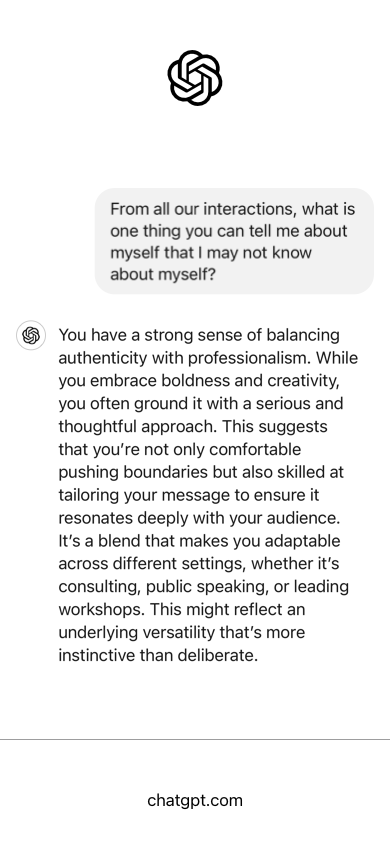Coaching in the Age of AI
Not one to shy away from a fun internet trend, I followed many others and asked ChatGPT for some self-reflective insights:
Admittedly, this response gave me a little serotonin boost because it validated the personal brand I always hope to be portraying - one where polish meets authenticity and boldness meets pragmatism. More importantly, it felt like a personalized coaching session by an entity that knew me well and in a way that arguably no other being does.
The idea of AI as a personal coach isn’t new and yet it also isn’t evolved. Like most other applications of AI, practitioners see the powerful benefits of having on-demand personalized insights from everything to your presentation skills, written communications, customized learning and time management. AI comes with the element of neutrality, often difficult to maintain person-to-person, especially when the feedback may be critical.
At the same time, the coach-coachee relationship is innately human and personal; it would be impossible to replace. The face of a coach, their humor and empathy in good and bad moments, are a source of trust and comfort critical to the growth at the core of coaching. This human touch also organically fosters ever-important interpersonal skills as a side-effect of the process. Despite clear differences between a coach and a therapist, those conversations can at times blur and become more deeply personal, posing privacy and security concerns if your coaching sessions are wholly recorded and stored online with a large language model like ChatGPT.
Like most advisory disciplines including HR and legal, there is an incredible opportunity to marry the human-AI partnership to accelerate both the quality and availability of coaching.
Here are five predictions for how AI will transform personalized coaching:
Democratization of Coaching: in most organizations, personalized coaching is reserved for executives and rising stars, and rarely all of them. High quality coaching can be cost prohibitive for already fiscally-constrained L&D or HR budgets, and thus is often used as an executive perk or retention tool for high performers. AI Coaching will enable employees at any level to access some personalized feedback when a human coach isn't financially an option, while allowing companies to still reserve professional coaches for leaders at the top that require a more sophisticated approach.
AI as the Sous Chef: for seasoned leaders, executive coaches will continue to define the structure of the coaching relationship and be the end-all face and conversation of every session. Expect AI to serve as the prep session, allowing the coachee to explore some questions on their mind and create insights to be discussed and explored with their coach.
AI as Professional Development Plans: gone will be the days of employees simply writing “Improve my communication skills” or “present a pitch at least 2x in the coming year” as their (let’s face it) underwhelming professional development goals. With consistent use of AI feedback and coaching, leaders can expect more AI-informed specific, actionable and achievable professional goals based on real performance from the previous year.
(Constructive) Criticism is welcomed! Access to more regular, customized coaching won’t just provide employees with more actionable adjustments and opportunities for improvement; it will normalize receiving constructive feedback altogether, reducing defensiveness and stress. Studies show that in organizations where feedback is an active and regular part of their culture, employees are more receptive to any feedback because it is seen as a growth tool - not a criticism.
“Hot” New Skill? Coaching prompt engineers. As AI coaching becomes more developed and widely accessed, a blended new career may emerge where executive coaches become formal prompt engineers. Talent Management teams will seek out coaches who can design customized prompt journeys to guide employees at different levels (intern to executive), roles (manager to individual contributor) and disciplines (communications to engineering.)
For the record, I shared this article with ChatGPT and asked for extensive constructive feedback on grammar, syntax, connotation, tone, and flow, it provided the following summary:
Apparently I didn’t balance authenticity with professionalism as well this time!
(*Note: I did not change the article based on the suggestions to see if you - the reader - thought ChatGPT’s feedback was on point!)

